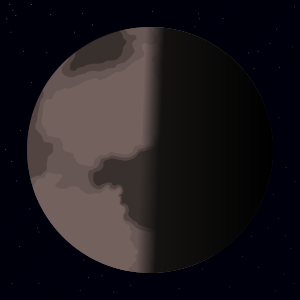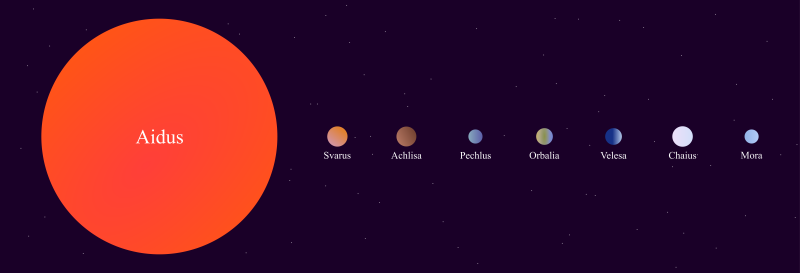Svarus
|
Svarus Svárus Svarera | |
 Svarus as seen from space | |
 Svarus' orbit in the Aidus system | |
| Designations | |
|---|---|
| Names | Svarus, Aidus b |
| Adjectives | Svaran |
| Orbital characteristics | |
| Apoapsis | 1.505x106 km |
| Periapsis | 1.671x106 km |
| Semi-major axis | 1.720x106 km |
| Orbital period |
36.26 hours (0.248 uecs) |
| Inclination | 1.27° |
| Satellites | None |
| Physical characteristics | |
| Mean radius | 7,118.001 km |
| Circumference | 44,723.719 km |
| Surface area | 6.371×108 km2 |
| Volume | 1.510×1012 km3 |
| Mass | 6.074x1024 kg |
| Density | 5.425x1012 kg/km3 |
| Surface gravity |
10.8 m/s2 (1.101 Og) |
| Escape velocity | 10.673 km/s |
| Axial tilt | 5.439° |
| Albedo | 0.766 geometric |
| Atmospheric characteristics | |
| Equilibrium temp. | 307.3 Kelvin |
| Surface pressure | trace (<0.5 nPa) |
| Composition by volume | Helium, atomic hydrogen, atomic oxygen, sodium, calcium, potassium |
Svarus (Volsh: Svarus, Langin: Svárus, Podchin: Svarera) is the closest planet to Aidus in its planetary system. Svarus is the third-most massive planet in the system at 1.201 Om, making it more massive than Orbalia but less massive than Chaius. With a equatorial radius of 1.196 Or, it is the second-largest body in the system by absolute size, with only Chaius being larger. Due to its tight orbit of 0.397 OO around Aidus, Svarus completes a full revolution every 0.248 uecs, or roughly, once every 36 hours.
Svarus' proximity to Aidus is considered a major influence on the planet's environmental conditions. Like all planets in the Aidus system, it is tidally locked to its parent star, with one side perpetually facing the star and the other perpetually away from it. The entire planet has an equilibrium temperature of 397.6 Kelvin, almost 100 degrees higher than Orbalia. Unlike the outer planets in the system, Svarus has little-to-no atmosphere; continuous exposure to high concentrations of solar wind from its star has resulted in a complete stripping of atmosphere over hundreds of billions of uecs. While the close proximity and weak atmosphere of Svarus to its star results in an extremely hot dayside environment bombarded by cosmic rays, the nightside of the planet has regular temperatures as low as 90 Kelvin.
The atmospheric conditions on Svarus resemble those of Achlisa such that the two closest planets to Aidus are sometimes considered "sister worlds." Both planets have minimal atmospheres compared to the outer five planets in the system, although Svarus' atmosphere is significantly more depleted than Achlisa's. Modern exologists posit that unlike Svarus, which receives the highest amount of stellar flux and cosmic ray bombardment of any planet in the system, Achlisa's atmospheric depletion is more due to extreme temperature conditions from prolonged previous experience of runaway greenhouse effect. In this regard, Achlisa may have once resembled the steam world Pechlus with its thick nitrogen-oxygen atmosphere, whereas Svarus is thought to have never achieved a significantly developed atmosphere.
Due to the extreme conditions on Svarus' surface and the high delta-v required to reach the planet, human development on Svarus has always been very minimal. The planet's high dayside temperatures could be withstood by modern materials, but extreme radiation levels would make any prolonged habitation unhealthy. While the planet's nightside would thus be the more attractive place for long-term habitation, reaching the planet requires the highest change in velocity of any other in the system. Additionally, where even Achlisa has a substantial amount of oxygen capable of being mechanically utilized in its thin atmosphere, Svarus has little to no available sources of planetary oxygen aside from sparse water-ice deposits. Hence, as other, more habitable worlds in the system are also economically underdeveloped, Svarus consequentially has seen little modern and historical interest as a candidate for permanent human activity.
Etymology
The origin of the word Svarus is unclear. Supporters of the Zemaian migration theory propose that like the name Aidus, Svarus may originally derive from the name of a god in Zemaian mythology. In Volsh, the closest word to Svarus is svarth (adjective, lit. "black"), and because of Svarus' prominent magnitude in the night-sky as viewed from Orbalia, the term Svarus is not considered to be Volsh in origin.
Instead, a majority of modern etymologists propose that the name Svarus descends from Podchin, of which there are two likely candidates: svarít (verb, lit. "to cook, boil" or "to smelt, weld") and svara (noun, lit. "quarrel, squabble"). The former is the more popular of the two, implying that Svarus was a venerable craftsman god, whereas the latter, albeit less popular, may have been a guardian or warrior god of some importance due to its proximity to Aidus.
Exology
Svarus is the closest planet in the Aidus system to the eponymous star. Like all other planets in the system, it moves in a precise 8:5 orbital resonance with the next furthest planet Achlisa; for every eight revolutions Svarus completes around Aidus, Achlisa completes five. Due to conditions at the formation of the Aidus system, this orbital resonance been stable for hundreds of billions of uecs and is predicted to remain as such. Also like all other planets in the system, Svarus is tidally locked to Aidus, with one side of the planet always facing the star and the antipodal side always facing away from the star.
Svarus completes one full revolution around Aidus in 36 hours, 15 minutes, and 35.3664 seconds, equivalent to one orbit every roughly one quarter uec (0.2481 uecs). The orbital inclination of Svarus to the elliptical plane of Aidus is a low 0.272º, consistent with the low values of inclination exhibited by other planets in the system. Also like other bodies in the system, Svarus has a very low eccentricity of 0.00622, meaning that its orbit is very close to perfectly circular around its host star. Additionally, it has a very small axial tilt, at a mere 2.09º from its rotational plane.
With a mean radius of 7118 kilometres, Svarus has an equatorial circumference of 44,723.718 km and a total surface area of 636.687 million km2. Due to its small axial tilt, there is only very slight area variations in the dayside and nightside of the planet around the polar regions. Temperatures on the dayside average around 503 Kelvin (approximately 230º C) and on the nightside average around 90 Kelvin (approximately -183.15º C) for an overall equilibrium temperature of 397.6 Kelvin. Svarus' dayside is host to the highest measured planetary temperatures in the Aidus system.
Svarus has a gravitational pull of 10.80 m/s2, roughly 1.109 Og. This is the highest of any planet in the system, and it makes Svarus the only planet to have a gravitational pull greater than that of Orbalia. Due the planet's proximity to Aidus, it requires the greatest delta-v of any planet to be reached via spacecraft.
Atmosphere
Svarus is the only planet in the Aidus system to lack significant atmosphere, although it does have a minimal exosphere. The exosphere is dominated by helium and hydrogen trapped from solar winds by Svarus' magnetic field; in addition to these primary components there is a myriad of other trace elements including oxygen, sodium, calcium and potassium likely sourced from surface sublimation. Svarus is believed to be too hot and relative to its gravitational pull to have ever maintained a stable atmosphere in its planetological history, unlike its sister planet Achlisa, which has been undergoing atmospheric out-gassing since its formation to result in its presently thin atmospheric envelope.
There are trace amounts of water ice in the polar craters of Svarus which never receive direct sunlight. Sublimation of this water ice is thought to be the second-most prominent contributor to the hydrogen and oxygen in Svarus' minimal exosphere. The gradient at the terminator line, i.e., the transitory zone between the planet's dayside and nightside, is thought to never exceed temperatures higher than 180 K (approximately -93º C), but due to the planet's slight tilt, there are small time periods which water-ice may see temperatures greater than its freezing point. The extreme surface temperatures in conjunction with high solar radiation are thought to make Svarus the least suitable planet in the system for the existence of biological life.
Geology
Svarus has the lowest ratio of water-to-mass of any planet in the Aidus system. It is primarily composed of silicate rock and iron, being close in composition to the terrestrial half of Orbalia. Svarus is geologically active and displays the most pronounced volcanism of any planet in the system. Tidal interactions with Aidus are thought to be the driving force behind this activity. As a consequence of its orbital proximity to Aidus and its geological activity, the surface of Svarus is relatively smooth and non-cratered. The sweeping volcanic plains of the planet are composed primarily of basalt and andesite, and rhyolite is not uncommon.
Human history
There is limited archaeological evidence that Svarus was visited by humans during the Forgotten and early First Ages. During the Sundering War, there were brief encounters between Divine and Velesan scouts, as there was suspicion from both combatants that the planet may be used as a hold-out point. Despite this, neither side ever established a permanent position on the planet.
During the Gilded Peace of the Second Age, several attempts were made at establishing profitable mining enterprises on the planet. Extreme Aidusal radiation, high transportation costs, and more accessible mineral resources on other, more habitable planets made Svarus remain relatively undesirable. Archaeological and archival evidence suggests that by the time of the Coalition War, the planet had once again fallen out of human interest.
Throughout the period of the Aidusian Empire in the contemporary Fourth Age, Svarus has for the first time been the subject of the formal claims under a human political entity. Like all other celestial bodies within the Aidopause, the Empire considers it a part of its territory. As Svarus has no permanent human habitation, it is considered a personal possession of the Emperor. The planet has no effective government aside from the Imperial Government, and as such it falls under the direct jurisdiction of the Imperial Constabulary.
There has been little contemporary interest in the settlement of the planet. Its environment remains too extreme and inter-orbital transportation costs too high compared to more accessible, habitable planets closer to the core space of the Empire. Although officially there are no humans inhabiting the planet, it is thought that the planet may occasionally be visited by independent prospectors or potentially even used as a safe harbour by inner system criminal elements.

